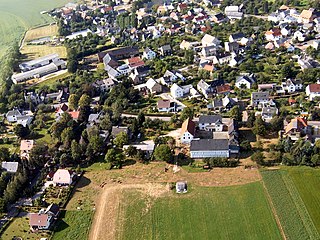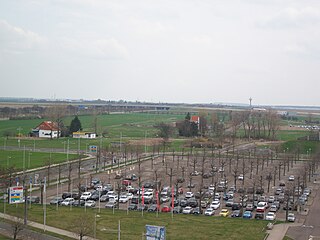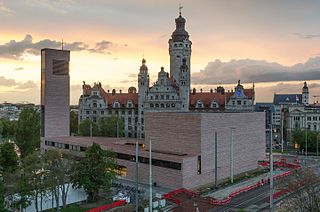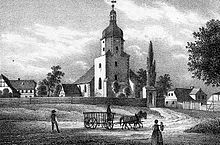
Merseburg is a town in central Germany in southern Saxony-Anhalt, situated on the river Saale, and approximately 14 km south of Halle (Saale) and 30 km west of Leipzig. It is the capital of the Saalekreis district. It had a diocese founded by Archbishop Adalbert of Magdeburg. The University of Merseburg is located within the town. Merseburg has around 35,000 inhabitants.

Halle (Saale), or simply Halle (German:[ˈhalə]; from the 15th to the 17th century: Hall in Sachsen; until the beginning of the 20th century: Halle an der Saale ; from 1965 to 1995: Halle/Saale) is the largest city of the German state of Saxony-Anhalt. It is the fifth-most populous city in the area of former East Germany after (East) Berlin, Leipzig, Dresden and Chemnitz, as well as the 31st-largest city of Germany. With around 244,000 inhabitants, it is slightly more populous than the state capital, Magdeburg. With Leipzig, the largest city of Saxony, Halle forms the polycentric Leipzig-Halle conurbation. Leipzig/Halle International Airport lies between the two cities, in Schkeuditz. The Leipzig-Halle conurbation is at the heart of the larger Central German Metropolitan Region.

Crimmitschau is a town in the district of Zwickau in Saxony, Germany.

Markkleeberg is an affluent suburb of Leipzig, located in the Leipzig district of the Free State of Saxony, Germany. The river Pleiße runs through the city, which borders Leipzig to the north and to the west.

The Thomanerchor is a boys' choir in Leipzig, Germany. The choir was founded in 1212. The choir comprises about 90 boys from 9 to 18 years of age. The members, called Thomaner, reside in a boarding school, the Thomasalumnat and attend the St. Thomas School, Leipzig, a Gymnasium school with a linguistic profile and a focus on musical education. The younger members attend the primary school Grundschule Forum Thomanum or Anna-Magdalena-Bach-Schule. Johann Sebastian Bach served as Thomaskantor, director of the choir and church music in Leipzig, from 1723 to 1750.

Geithain is a town in the Leipzig district, in Saxony, Germany.
Leipziger Verkehrsbetriebe GmbH operates one of Germany's largest tramway networks. The tramway network history is presented below in tabular form, including opening, electrification, and closing dates by segment. Street names of the time are used in the tables, with current names in (parentheses).

Kursdorf is a ghost village in Schkeuditz, Saxony, Germany. The site is located near the state border with Saxony-Anhalt. Situated between the two runways of Leipzig/Halle Airport, the village has been described as the "loudest village in Germany." Its population has declined since the mid-20th century, to the point that since 2017, the village has had no inhabitants.

Gohlis is a locality in the borough north of the city of Leipzig, Germany. Once a village and knightly estate (Rittergut), it became in 1838 a rural community (Landgemeinde). It urbanised during the Gründerzeit period of the 19th century and was incorporated into the city of Leipzig in 1890. Gohlis is now divided into three administrative localities, all of which belong to the Stadtbezirk Nord of Leipzig. Dominated by residential buildings from the late-19th and first half of the 20th century, Gohlis has a population of more than 45,000 inhabitants (2020).
The football league system of the German Democratic Republic existed from 1949 until shortly after German reunification in 1991.

TuRa Leipzig was a German association football club active before World War II from the city of Leipzig, Saxony. Successor sides included BSG Chemie Leipzig, which was part of East German football competition, and FC Sachsen Leipzig, which emerged following German reunification in 1990.

Lindenau is a locality of Leipzig, in Saxony, Germany. It is part of the Stadtbezirk (borough) Alt-West.

S-Bahn Mitteldeutschland represents an enlargement of the previous Leipzig-Halle S-Bahn. It is an electric rail public transit system operating in the metropolitan area of Leipzig-Halle, Germany. This S-Bahn network developed from two separate S-Bahn networks of Halle (Saale) and Leipzig, which were established separately in 1969 and then linked in 2004. With the opening of the Leipzig City Tunnel on 15 December 2013 as a new artery, the network was extended for the first time to the federal states of Thuringia and Brandenburg. With a system length of 802 km (498 mi), it is the largest S-Bahn network in Germany, displacing the long-time title holder Rhine-Ruhr S-Bahn from that position. The locomotive-hauled double-decker trains partly dating back to the DDR-era have been largely replaced by electric multiple unit Bombardier Talent 2 trains, but some older trains are still used during rush hour.
The following is a timeline of the history of the German city of Leipzig.

FC Sachsen Leipzig was a German football club from the Leutzsch district of Leipzig, Saxony. The club continued the traditions of BSG Chemie Leipzig. The club officially dissolved in 2011. Although several successor sides were established, only one survived, the BSG Chemie Leipzig. The name Sachsen Leipzig was revived in 2014 by amateur football club LFV Sachsen Leipzig.
BSG Chemie Leipzig was a German football club from the Leutzsch district of Leipzig, Saxony. The prewar identity of the club is rooted in the establishment of Britannia Leipzig in 1899 and its successor TuRa Leipzig. During the socialist era, the traditions of the club were continued in the East German teams BSG Chemie Leipzig and SC Lokomotive Leipzig before the emergence of FC Sachsen Leipzig following German reunification, which continued the clubs traditions.

BSG Chemie Leipzig is a German football club based in the locality of Leutzsch of the Alt-West borough of Leipzig, Saxony. It continues the traditions of the original club of the same name and its successor FC Sachsen Leipzig.

The Propsteikirche St. Trinitatis in Leipzig, Saxony, Germany, is a Catholic church in the city centre, at the southwestern corner of the Inner City Ring Road, opened in 2015. The parish is part of the deanery of Leipzig in the Diocese of Dresden-Meißen. The official name of the church is Propsteikirche St. Trinitatis Leipzig. It is the largest church built in the new states of Germany since reunification.

SV Merseburg 99 is a sports club from Merseburg in Saxony-Anhalt. The club has existed since August 23, 1899. The club colors are green and white. The club's home base is the Merseburg City Stadium.






























